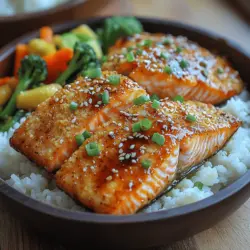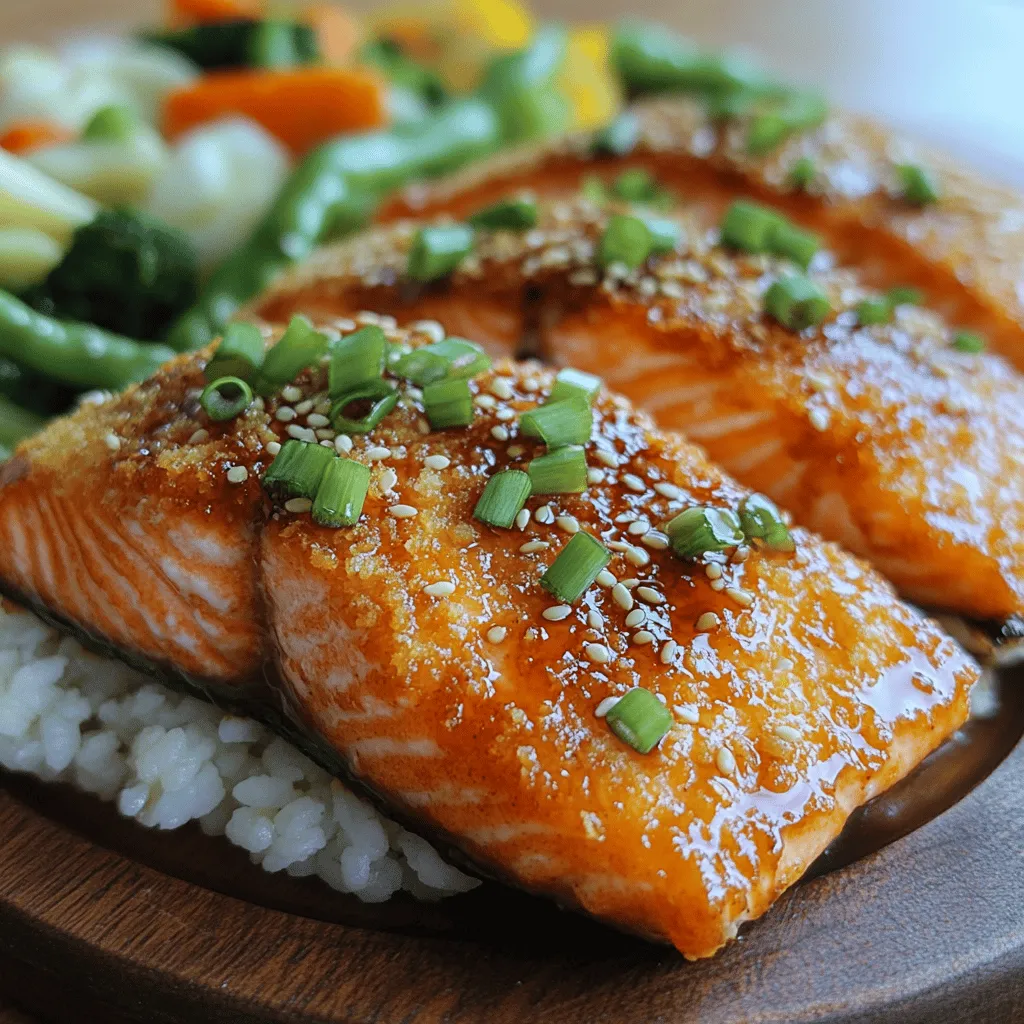Crispy Teriyaki Air-Fried Salmon: A Delicious Fusion of Flavor and Health
If you’re on the lookout for a dish that combines vibrant flavors, health benefits, and cooking convenience, look no further than our Crispy Teriyaki Air-Fried Salmon recipe. This dish highlights the tender, rich taste of salmon, expertly complemented by the sweet and savory notes of teriyaki sauce. With the air fryer as your secret weapon, you can achieve a perfectly crispy exterior without the added oil typically required for frying.
In this article, we will take you through the entire process, from selecting the freshest salmon to mastering the marinade and achieving that coveted crispy finish. This recipe is designed for both seasoned chefs and beginners alike, ensuring that you can impress family and friends with minimal effort.
Understanding the Ingredients
To create an exquisite dish like Crispy Teriyaki Air-Fried Salmon, understanding the ingredients is essential. Each component plays a significant role not only in flavor but also in nutrition.
The Salmon Fillets
Salmon is often praised as a healthful choice in the culinary world, and for good reason. Rich in omega-3 fatty acids, salmon provides numerous health benefits, including promoting heart health, reducing inflammation, and supporting brain function. Additionally, salmon is packed with high-quality protein, making it an excellent choice for maintaining muscle mass and overall health. When selecting salmon fillets, opt for wild-caught varieties whenever possible, as they typically boast a superior flavor and nutrient profile compared to farmed salmon.
Teriyaki Sauce: A Flavorful Base
Teriyaki sauce is a popular Japanese condiment that has gained global recognition for its unique flavor. Traditionally made from soy sauce, sake, mirin, and sugar, teriyaki sauce adds a delightful sweet and savory balance to dishes. Its origins date back to the Edo period in Japan, where it was used as a marinade and glaze for grilled meats. In this recipe, the teriyaki sauce enhances the natural flavors of the salmon while providing a sticky glaze that caramelizes beautifully in the air fryer.
The Role of Honey and Soy Sauce
Honey and soy sauce are two key ingredients in our teriyaki marinade that contribute to the dish’s signature flavor. Honey adds a touch of sweetness that balances the saltiness of soy sauce, creating a harmonious blend that enhances the salmon’s rich taste. Beyond flavor, honey also offers health benefits, including antioxidants and antimicrobial properties. Soy sauce, on the other hand, provides umami flavor and is a source of protein and minerals. When combined, these two ingredients create a marinade that elevates the dish to new heights.
Sesame Oil and Its Aromatic Qualities
Sesame oil is another essential ingredient that adds depth to the teriyaki marinade. Known for its nutty aroma and flavor, sesame oil is rich in antioxidants and healthy fats, making it a nutritious addition to your cooking. It also enhances the overall flavor profile of the dish, providing a subtle complexity that complements the salmon beautifully.
Fresh Garlic and Ginger: Nature’s Flavor Enhancers
No teriyaki dish would be complete without the aromatic duo of garlic and ginger. Both ingredients are not only flavor powerhouses but also offer numerous health benefits. Garlic is known for its immune-boosting properties and has been linked to heart health, while ginger is celebrated for its anti-inflammatory effects and digestive benefits. Together, they contribute a robust flavor and aroma that elevates the entire dish.
Panko Breadcrumbs for the Perfect Crunch
To achieve that irresistible crispiness on the salmon, we turn to panko breadcrumbs. Unlike traditional breadcrumbs, panko is lighter and flakier, which allows for a crunchier texture when cooked. This unique quality makes panko an excellent choice for air frying, as it adheres beautifully to the salmon, creating a delightful crunch that contrasts perfectly with the tender fish inside.
Marinating the Salmon: The Key to Flavor
Now that we’ve covered the essential ingredients, let’s delve into the crucial step of marinating the salmon. Marination is the key to flavor absorption, allowing the salmon to soak in the rich teriyaki flavors before it hits the air fryer.
Creating the Marinade
To create a balanced marinade for your salmon, combine the following ingredients in a mixing bowl:
1. 1/4 cup soy sauce
2. 1/4 cup honey
3. 2 tablespoons sesame oil
4. 2 cloves of minced garlic
5. 1 tablespoon of freshly grated ginger
6. Optional: a sprinkle of sesame seeds for garnish
Whisk these ingredients together until well combined. The result should be a glossy, thick marinade that clings to the salmon fillets.
Timing and Technique for Marinating
For optimal flavor infusion, it’s crucial to marinate the salmon for at least 30 minutes, although for best results, aim for a marination time of up to 2 hours. Place the salmon fillets in a resealable plastic bag or a shallow dish, pour the marinade over them, and ensure they are well-coated. Seal the bag or cover the dish and refrigerate. The longer the salmon marinates, the more pronounced the teriyaki flavor will be.
Preparing for Air Frying: Setting Up for Success
Before you start cooking your salmon, it’s important to prepare your air fryer to ensure the best results.
Preheating the Air Fryer
Preheating your air fryer is a crucial step that helps achieve that crispy texture. Set your air fryer to 375°F (190°C) and allow it to preheat for about 5 minutes. This ensures that the salmon cooks evenly and develops a beautiful crisp on the outside while remaining tender and juicy on the inside.
As you prepare for air frying, lay out your marinated salmon fillets and get your panko breadcrumbs ready for coating. The next steps will guide you through the air frying process, ensuring that your Crispy Teriyaki Air-Fried Salmon is a dish you’ll be proud to serve.
Stay tuned for the complete guide on cooking your salmon to perfection!
Preheating: The Key to Crispy Perfection
Preheating your air fryer is an essential step for achieving that desired crispy texture when cooking salmon. Just as you would preheat an oven, preheating your air fryer ensures that the cooking environment reaches the optimal temperature right from the start. This not only helps the salmon cook evenly but also allows the panko breadcrumbs to crisp up beautifully, creating that delightful crunch we all crave. The best practice is to set your air fryer to the desired cooking temperature for about 3 to 5 minutes before placing the salmon inside.
Coating the Salmon for a Crispy Finish
Achieving a crispy finish on your air-fried salmon involves a simple yet effective coating process. Follow these steps to prepare your salmon fillets for that perfect crunch:
1. Prepare Your Ingredients: Gather your panko breadcrumbs and any additional seasoning you wish to use. The panko breadcrumbs are crucial for creating a light and crispy exterior due to their larger flakes compared to traditional breadcrumbs, which can sometimes lead to a denser coating.
2. Marinate the Salmon: Begin by marinating your salmon fillets in teriyaki sauce for at least 30 minutes. This not only infuses the fish with flavor but also helps the breadcrumbs adhere better.
3. Coat with Panko: Remove the salmon from the marinade, allowing any excess sauce to drip off. This step is critical; too much moisture can hinder the crisping process. Next, place the panko breadcrumbs in a shallow dish. Gently press the salmon fillets into the breadcrumbs, ensuring an even coating on all sides. For an extra layer of flavor, you can add a pinch of garlic powder or sesame seeds to the panko.
4. Set Aside: Once coated, set the salmon aside on a plate for a few minutes to let the coating adhere firmly before air frying.
Air Frying Techniques: Achieving Crispy Perfection
Setting Up the Air Fryer
Arranging the salmon properly in the air fryer basket is crucial for even cooking and optimal crispiness. Follow these guidelines:
– Single Layer: Place the salmon fillets in a single layer in the air fryer basket. Avoid overcrowding, as this can lead to uneven cooking and prevent the hot air from circulating effectively around the fish.
– Spacing: Leave a bit of space between each fillet to allow air to flow freely. This will help each piece cook evenly and achieve that coveted crispy texture.
Cooking Time and Temperature
For perfectly cooked salmon, it’s important to set the right cooking parameters:
– Temperature: Set your air fryer to 375°F (190°C). This temperature is ideal for cooking salmon while allowing the panko to crisp without burning.
– Cooking Time: Air fry the salmon for about 10 to 12 minutes, depending on the thickness of your fillets. Thicker pieces may require a little extra time, while thinner fillets may cook faster.
Checking for Doneness
Knowing when your salmon is fully cooked is essential for both safety and taste. Here are some tips to ensure your salmon is done:
– Use a Thermometer: The best way to check for doneness is by using a meat thermometer. Salmon is perfectly cooked at an internal temperature of 145°F (63°C).
– Visual Cues: If you don’t have a thermometer, look for the flesh to turn from translucent to opaque and flake easily with a fork. The exterior should be golden and crispy.
Serving Suggestions: Complementing Your Teriyaki Salmon
Now that you have perfectly air-fried teriyaki salmon, it’s time to think about what to serve it with. Pairing your dish with complementary sides enhances the overall meal experience.
Classic Pairings: Rice and Vegetables
One of the simplest and most satisfying accompaniments to teriyaki salmon is rice. Here are a few options:
– White Rice: Fluffy white rice, cooked in a rice cooker or stovetop, absorbs the flavors of the teriyaki sauce beautifully.
– Brown Rice: For a healthier option, brown rice adds a nutty flavor and extra fiber to your meal.
– Steamed Vegetables: Pair your salmon with a side of steamed broccoli, carrots, or snap peas. These vegetables not only add color to your plate but also provide essential nutrients.
Garnishing with Green Onions
Don’t underestimate the power of garnishing! Fresh herbs and garnishes can elevate the presentation and flavor of your dish. Here’s how to enhance your teriyaki salmon:
– Chop Fresh Green Onions: Sprinkle chopped green onions over the salmon just before serving. The fresh, crisp flavor of green onions contrasts beautifully with the rich teriyaki sauce.
– Sesame Seeds: A light sprinkle of toasted sesame seeds adds a nutty crunch and a touch of elegance to your plate.
Nutritional Benefits of Air-Fried Salmon
Air-frying is not just a cooking method; it’s a healthier alternative that offers significant nutritional benefits compared to traditional frying.
Low-Calorie Cooking Method
One of the standout advantages of air frying is the reduction in calorie intake. Traditional frying often involves submerging food in oils, which can add unnecessary calories and fats. Air frying, on the other hand, requires little to no oil, allowing you to enjoy crispy textures without the added calories. This makes your teriyaki salmon a guilt-free choice for those watching their weight or looking for healthier cooking methods.
Omega-3s and Heart Health
Salmon is widely recognized for its health benefits, particularly its high omega-3 fatty acid content. These essential fats are known to promote heart health, reduce inflammation, and support brain function. By air-frying rather than pan-frying, you retain more of these beneficial nutrients, making your meal both delicious and nourishing.
Conclusion
Crispy teriyaki air-fried salmon is a delectable dish that tantalizes the taste buds while fitting seamlessly into a healthy lifestyle. With its simple preparation, quick cooking time, and impressive flavor, this recipe is perfect for weeknight dinners or special occasions. By understanding the ingredients, mastering the marinating process, and employing efficient air frying techniques, you can create a meal that is both satisfying and nutritious. Enjoy the delightful experience of homemade teriyaki salmon, and let it inspire you to explore more culinary adventures in the kitchen.



